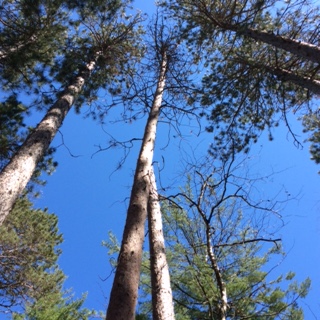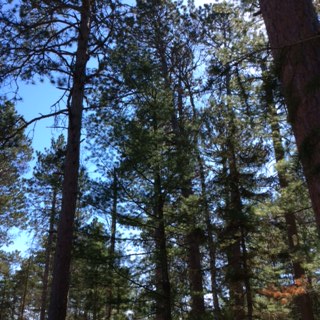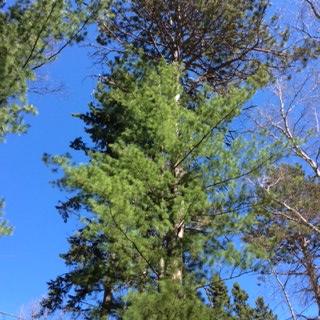Overview
This is a prospective case study describing a prescription that will be implemented sometime after spring 2018. This stand is located in the Smoky Hills State Forest with in the Smoky Hills High Conservation Value Forest. The goals of this HCVF is to maintain continuous canopy and develop uneven aged stands. The stand is also located on trust fund land. FDc34 is the dominant native plant community (see supplemental info for details), but the stand has inclusions of other NPC’s. The stand has steep terrain. The main cover type is even aged red pine that is 115 years old, and has scattered hardwoods and white pine scattered throughout.
Silviculture Objective(s)
Increase white pine and generate revenue while maintaining a canopy and creating an uneven aged stand. Increase white pine seedlings to 100 per acre 10 years after thinning.
Pre-treatment stand description and condition
Stand establishment and management history:
The stand was established naturally. Small commercial thinning occurred in the late 1970’s. The most recent commercial thinning occurred in 1991 (Y-5306). During that treatment, 60 MBF of mixed pine was sold on 65 acres.
Pre-treatment species composition:
This stand is an even aged natural 115 year old red pine stand. The red pine average 16” DBH and 65 feet to a 4” top. Total basal area is 147 ft2/acre. Red pine, white pine, jack pine, aspen, red oak, paper birch and sugar maple are the main trees species. There are pockets of 50 year old hardwoodswhere they were harvested in the 1970’s. There is a fair number of white pine seedlings (31/acre), saplings (11/acre) and pole (6/acre) sized trees in the understory. There is white pine of all ages in the stand. Sugar maple is dominate in the understory. There are pockets of dense red pines where BA exceeds 200 ft2/acre. These pockets have mortality from bark beetles. The mature oak is also 115 years old and has good form for oak in the Park Rapids Area. The sugar maple has poor form and has frost cracks. There are all ages of sugar maple scattered throughout the site.

Figure : Diversity of pine and hardwoods
Pre-treatment growth and stocking:
| Pre-Harvest Species Composition (Trees/Acres) | ||||||||
| Tree Species | 0" to 4" | 4" to 8" | 8" to 12" | 12" to 16" | 16" to 20" | 20" to 24" | Total | Percentage |
| Maple | 242 | 42 | 7 | 1 | 292 | 57% | ||
| Basswood | 4 | 4 | 1% | |||||
| White Pine | 31 | 11 | 6 | 3 | 2 | 1 | 53 | 10% |
| Balsam Fir | 15 | 1 | 16 | 3% | ||||
| Aspen | 1 | 1 | 6 | 5 | 13 | 3% | ||
| Red Pine | 2 | 2 | 15 | 37 | 15 | 6 | 77 | 15% |
| Oak | 7 | 11 | 5 | 23 | 4% | |||
| Ash | 1 | 1 | 0% | |||||
| Birch | 19 | 4 | 8 | 2 | 33 | 6% | ||
| Total | 314 | 69 | 53 | 53 | 17 | 7 | 512 | |
| Percentage | 61% | 13% | 10% | 10% | 3% | 1% |
Pre-treatment forest health issues:
The stand is transitioning to an over mature forest. The early successional trees are suffering from old age. White pine has problems with blister rust, porcupine damage, and deer browse on the seedlings. Bark beetles are affecting the red pine where there is high basal area and stressed trees. Rot exists in most of the other trees species.

Figure 1: Red pine stressed from competition, killed by bark beetles
Landowner objectives/situation:
The goals of this treatment is to maintain a canopy, produce a revenue, manage for old forest characteristics, maintain forest health, increase white pine and oak, and manage as an uneven aged forest so reoccurring treatments can occur every 15-20 years.
Silviculture Prescription
This stand has been marked for thinning. Trees were individually marked to be removed or kept. Old skid trails will be used from previous thinnings. The logging equipment will be processor and forwarder. The slash will be lop and scattered across the site. The harvest will take place during dry soil conditions. The thought behind the marking was as follows:
- Remove red pine where basal area is high and trees are stressed from competing. This should increase the forest health, improve tree growth, and produce revenue.
- Remove trees that are competing white pine or oak. This increases diversity, produces revenue, and increases the stand’s white pine seed source. Where there is abundant white pine, most of the red pine will be removed to create more growing space for the white pine.
- Remove pockets of mature hardwoods. This will regenerate intolerant species like oak, aspen, and birch. This will maintain the diversity in the stand.
- Reserve enough hardwoods that will allow another thinning possible in 15-20 years to release the white pine.
- Create enough soil disturbance from the logging which will create a receptive seedbed for white pine. This will establish the next generation of white pine in the stand.

Figure 3: Mix of mature red and white pine
What actually happened during the treatment
This stand was sold on auction in the spring of 2018.
Post-treatment assessment
5 years and 10 years after the thinning the stand will be remeasured to see if there is an increase in white pine seedlings after the thinning. The red pine BA will be 70 ft2/acre after thinning. There are 77 trees per acre before thinning and will be reduced to 50 trees per acre (33% of the volume)
Plans for future treatments
The stand should be examined again for another thinning treatment 15 years after the thinning.
Costs and economic considerations
Revenue generated from the thinning will be $80,643.23 at the current base price stumpage.
Revenue generated from clear cutting the stand would be $274,983.48 at the current base price stumpage.
Other notes
Potential problems could be that the sugar maple and hazel takes over the understory and outcompetes the white pine. With the current deer population in this area, the white pine might not get above browse height. Red pine numbers will decrease with this management and there will be eventually low numbers of red pine.
Submitted by
Kyle Anderson
Graduated from the University of Montana with a BS in Forest Management. Worked for the MN DNR Forestry for 10 years.
